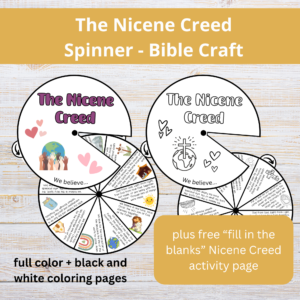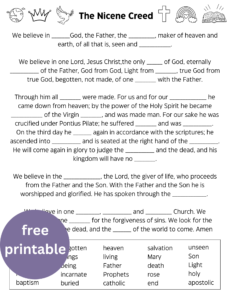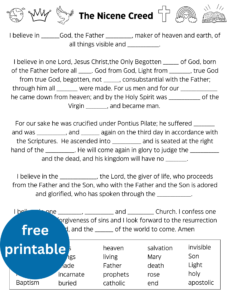The Nicene Creed is one of the great statements of the Christian faith. It is also one of the few ecumenical statements that all Christians believe in. (Our other things held in common are the Apostle’s Creed and the Lord’s Prayer.) This Nicene Creed activity is perfect to kids to help them memorize this important statement of faith. You can get your Nicene Creed fill in the blanks activity for kids right here (or scroll to the bottom of this post).
What is the Nicene Creed?
In Catholic churches, people recite the Nicene Creed each Sunday at Mass. The Nicene Creed is also used in Orthodox churches and Protestant churches.
The Nicene Creed summarizes the essentials of the Christian faith: We believe in one God who is Father, Son, and Holy Spirit. God the Father created all things. Jesus is God’s only begotten Son, who was born from the virgin Mary, was cruficied, died, buried, and rose again. The Holy Spirit comes from the Father and the Son (this is the “filioque clause” that was a matter of great controversy between the Eastern and Western churches, and it states that both Jesus Christ and God the Father are the origin of the Holy Spirit). The Creed also speaks of the unity of the church (the great body of Christ across time and space) and the promise of the resurrection.
The Nicene Creed (formulated in 325 AD) is longer than the Apostle’s Creed (written sometime in the second century AD) because it adds greater details and nuances to that classic statement of faith.
You can use the free printable Nicene Creed fill in the blank activity sheets below to help your kids memorize the Nicene Creed, or use this cute Nicene Creed spinner as a memory prompt that doubles as a craft.

There are a few different slight variations on the wording of the Nicene Creed, depending on which denomination you find yourself in. Catholic and Orthodox churches use a slightly different version than the ecumenical version that many Protestant churches use. And some Anglican churches use an older version of the Nicene creed found in the 1662 BCP (the 1975 ecumenical translation is found in the 1979 BCP) that has slightly different wording. All the versions of the Nicene Creed, though, express the same core beliefs of the Christian faith.
Roman Catholic Church
I believe in one God,
the Father almighty,
maker of heaven and earth,
of all things visible and invisible.
I believe in one Lord Jesus Christ,
the Only Begotten Son of God,
born of the Father before all ages.
God from God, Light from Light,
true God from true God,
begotten, not made, consubstantial with the Father;
through him all things were made.
For us men and for our salvation
he came down from heaven,
and by the Holy Spirit was incarnate of the Virgin Mary,
and became man.
For our sake he was crucified under Pontius Pilate,
he suffered death and was buried,
and rose again on the third day
in accordance with the Scriptures.
He ascended into heaven
and is seated at the right hand of the Father.
He will come again in glory
to judge the living and the dead
and his kingdom will have no end.
I believe in the Holy Spirit, the Lord, the giver of life,
who proceeds from the Father and the Son,
who with the Father and the Son is adored and glorified,
who has spoken through the prophets.
I believe in one, holy, catholic and apostolic Church.
I confess one Baptism for the forgiveness of sins
and I look forward to the resurrection of the dead
and the life of the world to come. Amen.
1975 Ecumenical translation
We believe in one God,
the Father, the Almighty,
maker of heaven and earth,
of all that is seen and unseen.
We believe in one Lord, Jesus Christ,
the only Son of God,
eternally begotten of the Father,
God from God, Light from Light,
true God from true God,
begotten, not made,
consubstantial to the father.
Through him all things were made.
For us and for our salvation
he came down from heaven:
by the power of the Holy Spirit
he became incarnate from the Virgin Mary,
and was made man.
For our sake he was crucified under Pontius Pilate;
he suffered death and was buried.
On the third day he rose again
in accordance with the Scriptures;
he ascended into heaven
and is seated at the right hand of the Father.
He will come again in glory to judge the living and the dead,
and his kingdom will have no end.
We believe in the Holy Spirit, the Lord, the giver of life,
who proceeds from the Father and the Son.
With the Father and the Son he is worshiped and glorified.
He has spoken through the Prophets.
We believe in one holy catholic and apostolic Church.
We acknowledge one baptism for the forgiveness of sins.
We look for the resurrection of the dead,
and the life of the world to come. Amen.
The Nicene Creed Lesson for Kids
A great way to teach the Nicene Creed to children is to read through the creed together, ask questions about it and have a discussion, and reinforce their learning with an activity.
A basic lesson on the Nicene Creed for kids:
- Read the Nicene Creed out loud together.
- Have students ask any questions that they have about the creed.
- Ask your own questions about what certain things mean. (What does “only begotten Son” mean? What do we hope for in the promise of the resurrection of the dead? What do you think the life of “the world to come” might look like?)
- Have students complete a coloring sheet, activity page, or craft to reinforce their learning.
Note: Don’t be afraid if students ask questions that you don’t immediately have an answer for. You don’t have to have all the answers! If they ask a question that you don’t know the answer to, simply say, “That’s a great question! Let’s explore that together.” Or “I will have to look into that and get back to you.”
Some of the words of the Nicene Creed might need to be explained.
Some of the most challenging words of the creed might be:
- begotten
- incarnate
- consubstantial
Explain that “begotten” means that Jesus is of the same being of God the Father. Jesus was not created like we (and the rest of the world) was created. “Begotten” means that Jesus is God’s Son, of the same being or “stuff” as God the Father. Because he is “begotten”, Jesus always existed; he wasn’t made at the beginning of time like humans and animals and the rest of the universe.
“Incarnate” means to have a body. When Jesus become “incarnate” it means that he took on a human body. Jesus became incarnate when Mary got pregnant with him.
“Consubstantial” means of the same being, or made of the same “stuff”.
Another word that might be worth exploring in the Nicene Creed is the word “resurrection“. Christian kids are often familiar with the word resurrection. But you could explore this word more and explain that it means that there is hope for life (with a body – we hope for bodily resurrection) after death. This is a great topic to have kids ask questions and wonder about. For instance: I wonder what a “resurrection body” will look like? Feel like? What will we be able to do in resurrected bodies? (Jesus ate food, just like any regular person, in his resurrection body – Luke 24:42 – and he was seemingly able to pass through walls or locked doors – John 20:19.)
How to Teach Kids to Memorize the Nicene Creed
The best way to memorize the Nicene Creed is simply to repeat it many times. Include the creed as part of your daily prayers. Recite it at the beginning or end of class (if you’re a teacher) or at the beginning or end of the day.
Another approach to memorize the Nicene Creed is to turn it into a game. Have kids complete a fill in the blanks activity sheet to help them remember key phrases of the creed. Or make a Nicene Creed craft that they can revist as they recite the words.
The Nicene Creed Fill in the Blanks Activity for Kids
Use this fill in the blanks activity page to help teach children the Nicene Creed. Below, you’ll find both the “We believe” translation and the “I believe” translation.


Download your copy of The Nicene Creed Fill in the Blanks Activity Page right here.

It provides educational insight and helps me explain complex terms like “begotten” and “consubstantial” more simply.